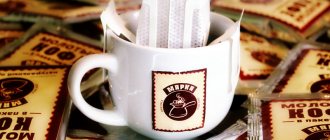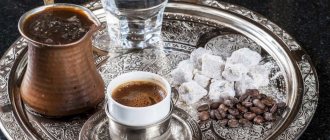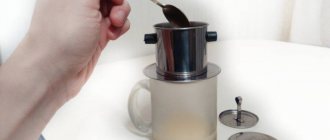General procedure
A dried, soaked coffee stain is almost impossible to remove. The washability scale is approximately as follows:
- 0-15 minutes: just rinse the fabric generously with warm water, for example, place it under a running tap;
- ¼-3 hours: the usual stain removers are effective, including a bar of laundry soap, as well as a solution of ammonia (1:1), glycerin (a few drops) or borax (a few drops);
- 3-72 hours: Soaking, powerful bleaches, etc. will be required.
- 7 days or longer - some fabrics will only need to be re-dyed or thrown away.
Fresh spots
What to do when a stain has been planted:
- Blot dry with a napkin. You cannot rub, otherwise the stain will be absorbed even more into the material.
- Wash the area where the stain was.
- If this is not possible, sprinkle with salt.
- Wash the entire item, adding stain remover.
Old stains
It is difficult to deal with old stains, but it is possible.
General procedure:
- Pour hot water or soak in it.
- Apply stain remover locally.
- Rinse off.
- Wash as usual.
We clean various materials from coffee stains
In order to save the item and not completely ruin it, it is important to remove coffee stains taking into account the material. After all, what is acceptable for cotton is deadly for wool. Therefore, you need to determine what material the clothes are made of.
Cotton and linen
Light-colored linen and cotton linen can be safely boiled or aggressive bleaches (bleach and others containing chlorine) can be applied to them. Oxalic acid, soda and laundry soap also show good results.
Silk
The fabric is capricious and delicate. When choosing a chemical, check in an inconspicuous area to see if it has changed the structure of the tissue. If the contamination is old, you can use glycerin and borax.
Wool
It is the most difficult to give in; due to its loose structure, it easily absorbs dirt.
- It is better to use ammonia and products containing it.
- For white wool, hydrogen peroxide is suitable.
- A solution of glycerin, ammonia and water will help remove old stains.
For ease of processing, place napkins under the woolen item and change them as they get wet.
Synthetics
For synthetic fabrics, vinegar, soda, and hydrogen peroxide are used. Can be used all together or separately. High temperatures, aggressive stain removers and chlorine are unacceptable for synthetics.
How to wash coffee from jeans
For denim, ammonia, citric, and oxalic acid are suitable. On denim in bright shades, check in advance to see if it changes color.
It is also acceptable to use dishwashing detergent. It is applied to the contaminated area and left for 30 minutes. After this, the jeans are washed as usual.
Features of working with different types of fabric
Depending on what material you spilled coffee on, methods for cleaning it are also chosen. The product you want to remove the stain with should first be tested on a small area.
Coarse cotton fabrics and linen
Bed linen made of thick cotton calico or a sundress made of linen can withstand most methods and are not afraid of high temperatures. However, boiling, bleach and concentrated acids severely damage the fibers.
It should also be remembered that natural fabrics with a small fluff (with weak twisting of threads and fibers) quickly and abundantly absorb liquids and are difficult to rinse. Chlorine-containing bleaches and products with strong odors are not recommended.
Denim
Denim fabric is quite durable and dye-fast, however, in hot water it shrinks strongly and loses color. Modern jeans contain elastane, so they require delicate solutions.
Colored knitwear
Almost all second-layer children's clothing is cotton jersey with a small amount of elastane. The same is used on T-shirts, tops, pajamas, adult walking T-shirts, robes, socks, etc.
Matter can be shed 1-1.5 tbsp. hot water, there will be no harm. However, washing or soaking in water hotter than 45 degrees will destroy the color and probably the print. Hydrogen peroxide, chlorine-containing bleaches, and a mixture of vinegar + soda + powder are contraindicated.
Tip To fix the color after all procedures, add 1 tbsp. l. vinegar before the final rinse. There will be practically no smell due to the low concentration of the substance. But the color will last longer.
Satin, silk, wool
Silk and wool do not tolerate contact with citric and oxalic acids, vinegar, and hydrogen peroxide. Silk, in addition, is afraid of hot water. Wool - long soaking.
Artificial fabrics
Artificial fabrics should not be cleaned with solvents, spilled with boiling water or soaked in hot water. Also, synthetics will not like contact with ammonia.
Suede
The material does not hold paint well, and the structure of the pile is very sensitive, so it is forbidden to wet suede too much, or to scrub it with aggressive agents. It is best to use vinegar or foam from dishwashing detergent.
Leather
The material does not tolerate an abundance of water, so semi-dry or wet methods are used: using gels or liquid products sprayed from a spray bottle (for example, vinegar). Then you need to restore the shine to the skin using glycerin.
Saving your favorite things
Removing a coffee stain from a white material is not difficult, provided it is cotton or linen. These natural materials can be boiled. You can get rid of coffee marks using ordinary laundry soap. Wash the item with it, and then boil the item for several minutes. This option will not work with delicate and colored fabrics. To clean the products you will have to use other means.
Folk remedies with vinegar
Almost every housewife has vinegar in her kitchen. This is a universal remedy for all occasions: it removes scale, is used to rinse hair, improves the taste of dishes, gets rid of ants, treats fungus, and also removes stains and preserves the color of clothes.
To remove coffee from fabric you will need to prepare:
- 60 g of any washing powder;
- 20 g baking soda;
- a few milliliters of 6% vinegar;
- several ice cubes (pre-freeze in the freezer).
Mix soda and powder. Gradually add vinegar to form a semi-dry mass. Dilute the resulting slurry with cold water to a paste. Wipe soiled clothes with an ice cube. This must be done on both sides of the fabric. Apply the prepared paste in a thick layer. Leave to act for five minutes. Then rub the mixture in with a clean dish sponge. If necessary, repeat the procedure. Complete the manipulations by washing and rinsing in warm water.
For the second recipe with vinegar you will need:
- 320 ml boiling water;
- 35 g sage;
- 5 liters of cold water;
- vinegar.
Pour boiling water over the sage and leave to steep for half an hour. Strain with gauze. Pour the infusion into molds and freeze. Pour five liters of cold water into a basin, put clothes and add ice. Soak for an hour. Then squeeze out and wipe the coffee-contaminated areas with vinegar mixed with water in a ratio of 1 to 3.
Using Lemon Juice
An ordinary lemon can perfectly cope with stains on clothes. The product can only be used on very light or white fabrics. You can use citric acid in a bag or freshly squeezed juice.
Pour 150 ml of water into an enamel pan. Add citric acid and bring water to a boil. You must wait until the contents are completely dissolved. After this, you can begin processing.
Wet the cloth around the coffee stain with cold water. Draw the acid solution into a syringe. Squeeze the contents onto the stain. Press the polyethylene on both sides and leave for half an hour. Wash the item by hand.
For the second method, you will need to squeeze the juice of two lemons. Moisten the stained area on the fabric with cold water. Apply the juice to the coffee-stained area thoroughly. Leave for several hours. After this, wash in the washing machine.
Ammonia
Ammonia is an excellent way to clean jeans.
Alcohol creates an alkaline environment on the surface of the fabric. It is capable of changing the structure of molecules in the coloring matter. This makes it easy to remove traces of organic matter. When buying a product, it is important not to confuse ammonia with ammonia. Ammonia is ammonium chloride. It looks like a white crystalline powder that is odorless. It is used as fertilizer and is useless for washing.
Ammonia, which is used to remove contaminants, is a 10% ammonium hydroxide solution. It has an unpleasant, pungent odor. Despite the name, it does not contain alcohol.
The first method is suitable even for delicate fabrics (silk and wool). For the procedure you should prepare:
- 50 ml of ammonia;
- 300 ml purified water;
- ¼ shavings of a bar of laundry soap.
Mix all ingredients and place in a water bath. Simmer for 10 minutes. Cool. Soak a cotton swab in the mixture and wipe the cloth several times. Rinse with water and repeat three to four times. After the last treatment, do not wash the mixture off the fabric. Wash the item in the washing machine.
You can clean jeans and other thick fabrics using the second method. For it you will need to purchase:
- 30 ml glycerin;
- 15 ml of ammonia;
- bath sponge;
- 40 g soda.
Mix glycerin with ammonia and add 250 ml of warm water, mix everything. Moisten the sponge in the prepared solution and treat the fabric at least five times. The mixture will be more active if it is warmed up a little. Complete the procedure by machine washing, adding soda instead of powder.
Laundry and tar soap
Many housewives use an old proven remedy to combat stains - laundry or tar soap. Whether coffee can be washed off with it depends only on the quality of the soap. It is necessary to choose a product of maximum concentration, at least 72%. It is not recommended to use laundry soap with additives like Antipyatin. This remedy is less effective.
To process all types of fabric, you will need to grate ¼ bar of soap on a fine grater. Pour boiling water over the shavings and stir with a wooden spoon until completely dissolved. Cool the homogeneous mixture. Soak a dishwashing sponge in the solution and apply to the fabric. Leave for half an hour.
After half an hour, take a toothbrush and rub the dirt. Apply the composition again. Repeat the entire procedure at least three times. After this, wash the item.
For white cotton, another method is more suitable:
- 350 ml of clean water;
- 40 g baking soda;
- 50 g soap shavings.
Place baking soda and soap in an enamel bowl, add water and boil. The composition can be used after all ingredients have dissolved. There is no need to cool it. Soiled clothes are laid out over the bathtub on a flat surface. The coffee stain is poured with a hot solution from a height of half a meter. Then clean the fabric with a toothbrush and wash it in the washing machine.
Turps
Turpentine (turpentine) oil does not leave greasy stains. It evaporates completely because it is volatile. It is used to dissolve enamels, paints and varnishes. It also works effectively on coffee stains.
To destroy coffee traces, prepare:
- 50 ml turpentine;
- 35 g fine salt.
Mix the ingredients in a ceramic bowl and spread the mixture over the stain on the clothing.
Leave for 40 minutes, then scrub with a brush. Repeat the whole process two or three times. After this, add the powder and soak in water for an hour. Wash. Mix oil and glycerin in equal quantities. Apply the mixture to a cosmetic disc and apply it to the stain. Leave the compress on for 25 minutes.
While the mixture is working on the stain, prepare a soaking solution: pour 120 ml of any dishwashing detergent into a bowl with 5 liters of water. Take the cotton pad from the product and place the item in the solution. Soak for 10 minutes, rub the fabric with your hands. After this, wash in any convenient way.
Borax or sodium borate
Borax is a grayish or colorless water-soluble crystal. With their help, they destroy mold, fight insects, wash pots and toilets, and wash clothes. It is recommended to wear gloves when working with the drug.
Moisten a cosmetic disc in medical alcohol, apply to the stain and leave for 10 minutes. Then rinse the product with warm water and prepare a mixture with borax. To do this, purchase a sodium borate solution at the pharmacy. Pour 30 ml of the product and mix it with 50 ml of whole milk. Soak a cotton swab in the mixture and treat the contaminated area of the fabric. After this, wash the item in a washing machine at 30 degrees.
For old stains, it is better to use this recipe:
- 45 ml of borax solution;
- 400 ml of clean water.
Mix water with borax. Soak the product in this mixture for 20 minutes. At the same time, mix lactic acid with water in a ratio of 1 to 4. Wring out the soaked clothes. Soak a cosmetic swab in the milk mixture and place it on the stain. Wait 10−20 minutes. Then use machine wash.
Simple methods with glycerin
Glycerin is a colorless liquid that belongs to the class of polyhydric alcohols. It is widely used in medicine, cosmetology, and the food industry. It can be used to easily remove even stubborn stains.
To destroy coffee traces, you will need liquid glycerin purchased at the pharmacy. Pour glycerin into an enamel container and heat on the stove. Soak a cotton swab in the warm mixture and use it to treat the stain on the clothing. Change the cotton pad to a new one as soon as it starts to darken.
After the coffee stain has lightened, pour a little glycerin onto it and leave it for 50 minutes. After this, wash the product by hand or in a washing machine. You can use any powder.
Mix glycerin and fine salt in equal proportions. It should be a paste. Spread it in a thick layer over the stain and cover it with cling film. After 10 minutes, the film is removed. The composition is rubbed into the fabric with your hands and washed off. The process is repeated again. At the end, the items are sent to the washing machine.
Despite the fact that coffee stains are considered difficult to remove, the listed methods allow you to save your favorite thing even in a seemingly hopeless situation. With these effective and affordable tools, you can revive even your favorite carpet or sofa.
For cleaning carpets and home textiles, cleaning with glycerin or ammonia is best.
Household chemicals
Laundry soap:
- For better results, rub the soap.
- Dilute with water to form a paste.
- Cover the coffee stain with the mixture.
- After half an hour, wash it off.
- If necessary, repeat the procedure.
Suitable for all fabrics and any stains; against old marks, soak in a concentrated solution. Soap is ideal for removing coffee from jeans.
Foam from dishwashing gel:
- The product is stirred in warm water and foamed.
- Use a dry sponge to pick up the foam and apply it to the stain.
- Blot or lightly wipe (if we are talking about leather or leatherette).
- Remove residues with a dry soft cloth.
The method is applicable against fresh stains on leather, leatherette, eco-leather and furniture upholstery.
Dishwashing liquid:
- The liquid is poured onto the fabric.
- Gently rub into the dirty area.
- Leave for 15 minutes.
- Wash off with warm water.
“Fairy”, “AOC”, etc. Removes fresh coffee stains well. The method is preferable if the drink was with milk or cream.
Window cleaning liquid with ammonia containing:
- Moisten the coffee stain with the product.
- Rub with a dry cloth.
- Wash with warm water and soap.
This product works great on stains on white clothes.
Bleach:
- Rub the stain with soap.
- After 10 minutes, rinse and soak in water with bleach.
- After an hour, rinse.
Used for white materials. Best brands:
- Amway,
- BOS,
- Ecover,
- Antipyatin.
Stain remover:
- Blot (but do not rub) the stain with a tissue to remove excess liquid.
- Rinse with hot water (but not boiling water!) from the wrong side.
- Treat the mark with stain remover. Before doing this, you can rub it with laundry soap.
- Then wash the item.
- If a trace still remains, reapply the product.
Stain removers are effective on fresh stains.
Radical measures: bleaching and boiling
Bleaching, like boiling, applies only to white linen and cotton:
- Water is heated in a large container to fit the item completely.
- Add bleach, laundry soap shavings or washing powder to warm water.
- After boiling, leave the product in the water for half an hour to two hours, depending on the contamination.
- After cooling, rinse the item in cool water.
You can remove coffee stains from any type of fabric. It is only important to use detergents correctly. Don’t rush to say goodbye to your favorite blouse or jeans, because you can solve this problem.
Removing Coffee Stains from Colored Clothes
When removing stains from colored clothing, it is very important not to harm the structure of the material, as well as the bright colors of the products. You should use special chlorine-free products with a mild effect or folk recipes that are gentle on the fabric.
Lemon juice
It is quite easy to remove coffee stains using regular lemon juice or citric acid crystals. This method fights unpleasant odors and returns the original color. How to remove a coffee stain using lemon juice:
- pre-cool the contaminated area;
- apply juice or diluted acid to the stain;
- wash off;
- wash the product according to the instructions.
The best results are obtained by using lemon on a cold cloth. You can wet the stain with low temperature water or walk over the stain with an ice cube. After this, juice or citric acid, diluted to a pasty state, is applied to the stain. The stain is left for 10-15 minutes, then washed with warm water with the addition of soap shavings or washing powder. At the end of the procedure, the item is washed in the usual way.
It should be remembered that it is best to remove any stains immediately after they appear. If it is not possible to immediately wash the stained item, then you can apply a little lemon juice to the brown mark and soak the item itself in warm water.
Serum
You can remove impurities from the invigorating drink using regular whey or kefir. Fermented milk products are quite effective in combating traces of tea or coffee. To clean the fabric as quickly as possible, it is recommended:
- wet the stained area;
- apply whey or kefir;
- rinse with cold water;
- wash.
Before applying the fermented milk product, the fabric must be moistened with warm water. Then a thick layer of serum is applied to the stain and the area around it. On average, it will take 30 to 60 minutes for a fermented milk product to break down the contamination. Afterwards, the stain is carefully washed with cold water, and the item is washed immediately.
You should not allow the serum to dry on the product or put off washing the item. This may cause the contamination to worsen and lead to an unpleasant odor.
How to remove difficult old stains
Many housewives use simple folk remedies that have been proven over many generations to remove stains.
Laundry soap
72% soap can remove various stubborn stains. The item is moistened and the contaminated areas are rubbed with soap for 20-30 minutes. Then soak in the solution for 2-3 hours. Cotton fabrics, if necessary, can be boiled in the same product.
Aspirin and hydrogen peroxide
Hydrogen peroxide is included in many commercial bleaches. It can remove stains from synthetics, linen and cotton. The white item is soaked in laundry soap, then peroxide is applied to the stain for 3-5 minutes.
Aspirin tablets are ground to a powder, slightly diluted with water, and the paste is applied to the stains for 10-20 minutes.
Table vinegar
9% vinegar is used to remove grass, sweat, and tea stains. When you add vinegar while rinsing, the item becomes white and soft.
Ammonia
A solution for removing stains is a tablespoon of ammonia per glass of water. Apply the product for a few minutes, then rinse and wash.
Alcohol with water
Coffee and other stains are quickly removed with a solution of ethyl (medicinal) alcohol. Take a teaspoon of alcohol per glass of water.
How to remove coffee stains from upholstered furniture
Many of us love to enjoy a cup of aromatic drink while sitting on our favorite sofa or sofa. Accordingly, these interior items also often become damaged by coffee.
Upholstered furniture also suffers from coffee stains
A fresh stain on microfiber upholstery should first be thoroughly blotted. To do this, use kitchen towels or a clean, plain fabric in light colors.
- Apply 1-2 drops of dishwashing detergent or liquid soap to a sponge.
- Rub the stain until foam forms.
- Remove the cleaner with a damp cloth and wait until the upholstery is completely dry.
Use a clean kitchen sponge to apply detergent to the upholstery of the sofa.
Dried coffee stains on upholstered furniture are a more difficult task.
- Mix 1/2 cup of water and the same amount of table vinegar.
- Apply the solution to the contaminated area and wait 10 minutes.
- Remove the cleaning agent using a tissue.
- If the stain does not disappear, repeat the procedure several times until the upholstery is completely clean.
An old stain from furniture can also be removed using alcohol:
- Dampen several paper towels with alcohol.
- Apply them to the stain and leave for 2-3 minutes.
- Repeat the manipulations until the coffee stain disappears.
In both the first and second cases, do not forget that the final step in cleaning the upholstery is to remove the active substance with clean water and dry the surface.
After removing stains, the surface of the furniture should be dried
Stains on leather upholstery can be removed with warm water. If coffee has already been absorbed into the leather, use a neutral detergent or a special product for cleaning leather products: lightly rub the upholstery with a soft cloth with the addition of the above products, then remove any remaining substances with a dry cloth. Unprofessional detergents damage the protective fat layer of leather upholstery, which can lead to damage to the furniture.
To remove a fresh coffee stain on a leather sofa, simply wipe the stained area with warm water.
How to remove marks from carpet
Sometimes a cup of coffee spills at the most inopportune moment on your favorite beautiful carpet. In such a situation, housewives are puzzled by only one question: how to save the decoration of the room and remove the stain from the carpet. First of all, you need to blot the remaining liquid with a napkin. And then you can use auxiliary means.
Vanish
Vanish will help remove coffee stains. This is a special product designed for such contaminants. Treat the smeared area with it in accordance with the instructions indicated on the package. The product simply treats the stain; the remaining composition is washed off with a cloth and water.
See also
How and with what you can quickly remove henna from the skin, 17 best removal products
Glycerol
To remove such a stain, you should try using glycerin. Two glasses of water should be mixed with a small spoon of this substance. Moisten the stain generously with the resulting solution. After 15 minutes, the remaining product is removed and the treated area is washed with warm water.
Ammonia
A large spoonful of ammonia should be diluted in a liter of water. The dirty area is moistened with the prepared solution. Then it is rubbed with a brush, wetted again and left for half an hour to act. The treated area is finally washed with warm water.
How to get rid of stains with vinegar?
This universal remedy is always on hand. In almost all cases of stain removal, vinegar is required, not acetic acid, so in order to obtain a lower concentration of this substance, we provide you with the correct proportions for diluting the essence.
Table “How to dilute vinegar?”
Vinegar and acetic acid:
- will help eliminate tea on colored clothes (this method will also require alcohol)
- Can remove acrylic paint and watercolor
- removes scorch marks from iron
- cleanses limescale and urinary stones in the bathroom
- will defeat yellow sweat stains on white clothes
- will cope with many old stains and mold
As you can see, this substance can clean a large number of stains on various types of materials.
What not to do
Not only does coffee have a rich color, clearly visible even on dark fabrics, it contains tannins that quickly penetrate the fibers and become fixed there. Therefore, the first advice is: do not panic. And under no circumstances should you try:
- blot the stain with force with a napkin: this will expand the area and depth of the contamination;
- washing the item in hot water will make the situation worse;
- bleach coffee stains on colored fabric - it will become discolored;
- Using acetone, gasoline, or acids to clean delicate items will ruin the item.
Here's what you need to do: start removing the coffee stain immediately. If you are in a hurry and only have enough time to change clothes, do not throw the soiled item into the dirty laundry basket. Do at least the “introductory part”: prepare the item for a thorough evening cleaning.











